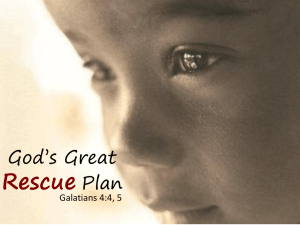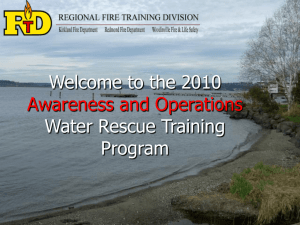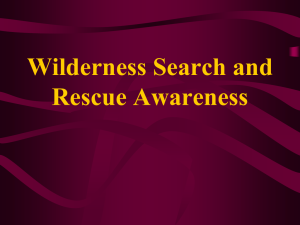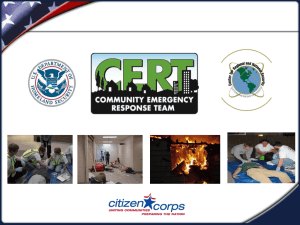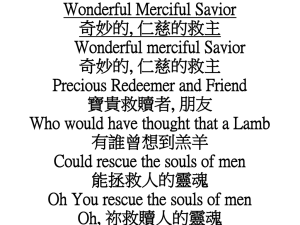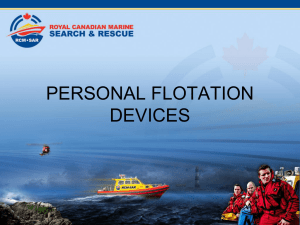Welcome to the Zone 1 Water Rescue Awareness
advertisement
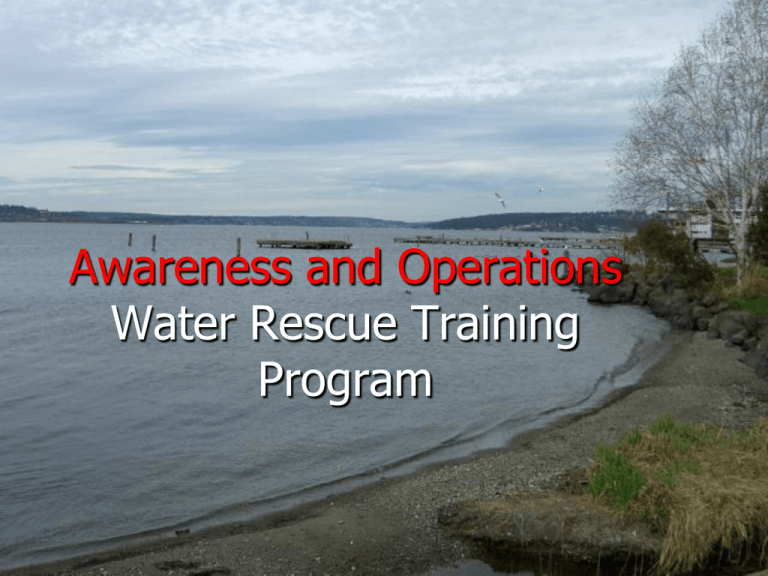
Awareness and Operations Water Rescue Training Program The Goals of this class: Identify what NFPA Standards and WACs apply to water rescue. Identify a water rescue and its hazards. Identify the signs of hypothermia. Identify the capabilities of awareness and operations trained personnel. Goals continued… Identify the difference between Rescue and Recovery. Identify the resources that are available to us during a water rescue. Identify the components of scene control. NFPA/WACs What does the NFPA say? NFPA 1006 Chapter 5 entitled “Water Rescue” and NFPA 1670 Chapter 7 “Rope” and 9 entitled “Water” apply to us. NFPA categorizes water rescue in four ways: • Dive • Ice • Surf • Swift Water But what about near shore still water rescue? What does the Law say? WAC 296-305-05503 “ The employer shall provide training and education for all members commensurate with those duties and functions that members are expected to perform.” “Such training and education shall be provided to members before they perform emergency activities.” The Near Shore Water Rescue program with the Awareness, Operations, and Technician Levels as developed by Zone 1 are to comply with these standards. Hazards What are the Hazards? • "Considering all the risks, do my resources • allow me to safely initiate a rescue at this time?" The decision to commit people to the rescue means weighing all of the risk factors against the possible benefit. Your personnel, training and equipment are important factors to consider in the size-up of risk potential. Assess variables such as: Weather Hazards • • • • • • Uncontrollable Hazards Weather High winds Temperature extremes Rain, snow and ice Fog Other Hazards • Water Temperature Current Poor access Visibility Other Hazards • Pollution- chemicals, fuels and oils Depth Logs Stumps Branches Muddy bottom Other Hazards • Submerged Objects Cables and lines Sharp metal and rebar Automobiles, appliances, junk metal Rocks and sandbars Broken glass Pilings and concrete Other Hazards • Bottom Conditions Soft bottom Holes and sharp drop-offs Water/sewer outlets and intakes Boat traffic- commercial and recreational Animals/shellfish Risk Benefit Analysis Risk Benefit Analysis - Is the decision making process that weighs the hazards encountered by the responder, versus the potential benefit from that exposure. Water Rescue Facts Statistics: 1/2 of the earth’s population will enter the water each year. Drowning is the #2 cause of accidental deaths for people under 44 years of age. More Statistics: Drowning is the #3 cause of death for all ages. 13% of all drowning victims are 4 years of age or younger. Most drowning victims are found fully clothed. 15% of water fatalities occur outside the normal June - August recreation season. Drowning Two types of drowning: Dry Drowning: Water covers a person’s breathing passages, enters their throat, and causes an effect called laryngospasm (blockage of the upper part of the throat by muscular contraction). Very little water enters the lungs. Wet Drowning: When the larynx relaxes, water enters the trachea and the lungs. The person dies from aquatic asphyxiation which occurs 90% of the time. How Do People Die in the Water? 1. Injuries / Illness before entering the water (seizure, heart attack, unconsciousness due to trauma or illness, intoxication) 2. Injuries / Illness after having entered the water (lacerations, seizure, heart attack, drowning) There are 2 Modes of Drowning: 1. Primary: Dying at the scene 2. Secondary: Dying within 72 hours of near-drowning What are the Signs of Drowning? 1. Head back 2. Mouth wide open (no sounds) 3. Arms in and out of water (more in than out of the water) 4. Head bobbing up and down in the water Most common factors contributing to Drowning: • Inability to swim • Cold water • Alcohol and Drugs The Dreaded Effects of Alcohol and Drug Abuse – A public service message! Suddenly falling into cold water produces 3 primary effects: 1. Involuntary gasp (Mammalian Dive Reflex) 2. Cardiac arrest 3. Performance and stamina decrease Our body temperature is normally 98.6*F. “Hypothermic” is anything below 98.6*F. Heat is lost 25 times faster in still water than in still air. This figure is 10 times greater in moving water Hypothermia 2 TYPES OF HYPOTHERMIA 1. Shell Hypothermia skin pale color difficulty holding objects pain loss of feeling blood vessels shut down 2. Core Hypothermia Most adults can last 15-20 min. before their core temperature is affected. Search Patterns Triangulation A method of pinpointing a position in a large area by way of using two or more intersecting lines of potential location, or “lines of sight”. The point at which the “lines of sight” or vectors intersect is the theoretical location of the subject of the search. Place your datum point marker here. Datum Point • Last known position of missing or drowning person. Datum Point Marker Search Patterns •Circular •Linear •Human Chain Circular Pattern • Circular or semi-circular coverage of area of probability when datum point is known Linear Pattern • Straight line pattern for coverage of an area of probability when datum point is not known. Human Chain •A searching mode utilizing many people to cover a large, shallow area in a short amount of time up to chest deep water with PFD on. Water Rescue Equipment Personal Floatation Device (PFD) Personnel responding to confirmed water rescue with no threat of fire or explosion may remove their bunker gear to improve mobility. • 1) Firefighters working on, over or along water, where danger of drowning exists, shall wear approved personal flotation devices. (This is not intended to include pools and hot tubs.) PFD’s Personal Flotation Device (P.F.D.) - any form or type of Coast Guard approved flotation gear designed to be worn by the user and to maintain some amount of buoyancy or flotation in the water. There are five types rated by function and design. – Type I - will float someone 'face-up' without effort – Type II- will float someone 'face-up' with a conscious effort'. – Type III- has no 'face-up' flotation design function. This is the most common type due to comfort and wear ability. This is also the vest issued to most crews. – Type IV - ring and horseshoe throw buoys. – Type V - oral and CO2 cartridge inflatable devices and special work suits. Rescue Adjuncts • Tubes • Buoys • Search lines Rescue Tube • Flotation tube used for rescue. Ring Buoy Ring Buoy / Horseshoe Buoy - A bright orange, 4-7 lb. ‘ring’ or ‘horseshoe’ shaped urethane foam float with a haul-back or grab line attached. Designed to be thrown to a victim and retrieved via the rope. Line Signals • Communications by rescue swimmer and line tender on search line by means of pull Line signals 1 2 3 4 Tender to Swimmer tug = Are you OK? tugs = Stop, change direction, take out line tugs = Stop, look at the line tender tugs = Help Line Signals 1 2 3 4 Swimmer to Tender tug = I’m OK tugs = Need more line tugs = Found object tugs = Need help Throw Rope 75' of polypropylene rope packed or 'stuffed' in a nylon bag. Rescue vs. Recovery Rescue Mode Rescue Mode - Operations undertaken by responders to remove victims from hazardous situations in which the victims are able to offer little or no assistance due to their physical condition or immediate environment. Person has been under water for <60 min. Quick Rescue Mode – Victim can be seen struggling in water or has just gone under prior to F.D. arrival. Immediate action is needed. Risk a lot to save a lot! Recovery Mode •Recovery Mode Operations undertaken by responders to recover victims, their remains, or property. Operations should only be implemented when the risk to responders has been reduced to the lowest possible level. Person has been under water for >60min. Quick Rescue Mode • Complete size up, establish command, determine rescue • • • • • or recovery and develop IAP Interview witnesses and establish datum point upon arrival unless victim is visible. Try to reach victim with throw bags if he/she is visible Have two rescuers set up for the rescue if it can be done at the Operations Level. If not- Call for PCSORT, Sheriff, etc. Have two back up rescuers ready – Two-in/Two-out This is the minimum number of personnel for a quick rescue! Incident Command and the Water Rescue Scenario where we are not in quick rescue mode. • We have not seen the victim • Patient has a known “down time” of more than a few minutes • Think about a correlation with survivable space in a fire • Risk a little to save a little… • We will not imperil ourselves unnecessarily Command & Control It is the IC responsibility to fill these positions if not assigned • Assign Positions – Rescue Group Leader – Safety Officer • Establish and maintain safe zones – Hot, Warm, Cold zones • Call for resources Rescue Group Leader is responsible for: • Determining & Implementing action plan • Overall rescue management • Designation of team leader • Questioning witnesses • Triangulation/datum point Back Up Team • This is the “water version” of RIT • Have all equipment needed for teams. Entry Team Leader is responsible for: • Safety and management of the rescue team • Preparation and Coordination • Communicate with other teams • Oversee all PPE is used correctly and properly equipped. Support Team Leader • Handles all accessory tasks • Prepares boat/PWC • Assist in triangulation • Helps with crowd control • ID’s hazards • Lighting support • Decontamination Staging Officer • Organizes and manages all equipment and personnel in a resource area. • Rehab Safety Officer • Responsible for overall scene safety • Must ID all scene hazards. • Ensures all personnel are wearing the proper PPE and working within their means and level of training. Medical Group Triage Treatment Transport Qualifications and Training What can each Level do? • Awareness - Can’t go in the water. • Operations - Can go in the water with Type lll PFD up to your waist. Size Up/ Scene Control How do we size up a water incident? • What have you seen and heard? • What help do you need? • What are the hazards? • What can you do safely? How do we control the scene? • Establish ICS • Call for resources • Establish Zones – Hot - Water and beach/dock – Warm - Area between beach and emergency apparatus or set up area – Cold - beyond apparatus Rescue Operational Zones Hot Zone: The area of the rescue operation where specified personnel may be placed at risk. Only rescue personnel directly involved in the operations and equipped with the proper safety equipment are allowed in this area. Rescue Operational Zones Warm Zone: The area between the hot zone and the cold zone that contains personnel and equipment essential to the support of the rescue effort. This area may contain the Command Post and Staging area. Control of this area is essential for the management of the rescue. Rescue Operational Zones Cold Zone: - A safe area at a rescue incident, outside the warm and hot zones. The area where apparatus, personnel and equipment not actively involved in the rescue are placed. Base should be located here. The media, bystanders and non-essential personnel will also be in this zone. Often asked Questions 1. Can FF go under water? Operations Level - A firefighter can go under water in waist deep water. 2. Can firefighters do a search in the water? Operations level – A firefighter can do wading assist, human chain and line searches as long as the water is only waist deep and you are wearing a Type III PFD. Often asked Questions 3. What do we wear as a minimum for Water Operations? Operations Level: Type III PFD U.S. Coast Guard approved. Technician Level: Type III PFD U.S. Coast Guard approved, plus a knife and whistle.* Thanks for attending!!! Be safe out there!!!
